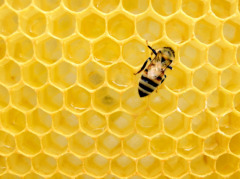Remember the Important Role Honeybees Play in the World
How important is the honeybee to the human diet? The US Department of Agriculture says that bees typically pollinate 80% of flowering crops. This is a third of everything that we eat. Their loss would not just affect dietary staples like strawberries, broccoli, nuts, apples, asparagus, cucumbers, and blueberries. It may also pose a threat to the beef and dairy industries if there is no alfalfa to feed the animals. A study from Cornell University made the estimate that should honeybees disappear, we would see a loss of most of our insect pollinated plants. This could potentially reduce our diet to little more than water.
Cross-Pollination
When it comes to cross-pollination, bees are invaluable. There are many plants that rely heavily on certain types of bee for reproduction. An example would be the red clover, which bumblebees pollinate. Many types of orchid are also included. Using insecticides has created the side effect of killing off bees that usually maintain crops. Environmental stresses, as well as several species of parasitic mites, caused mass devastation to the honeybee population in the USA at the start of the righties.
As a result, farmers had to rent bees from keepers to ensure that crops were pollinated. Of course, this also had a disastrous effect on the pollination of wild plants. Recent years have seen commercial honeybee hives suffer from colony collapse disorder. For reasons unknown, many bee boxes were empty after overwintering. In addition, venom from bees was discovered to have medicinal properties. It is used to treat issues like arthritis, fibromyalgia, multiple sclerosis, sexual dysfunction, epilepsy, depression, and cancer.
Pollination Explained
Pollination is the act of transferring pollen from a flower’s anther (the male part) to the stigma (the female part). There are plants that can pollinate themselves, usually by passing pollen along the same flower. However, many plants need pollen transferred between different flowers or different individuals of the plant. The former is known as self-pollination, the latter cross-pollination. Both can be done in different ways.
Bees usually pollinate flowers that bloom during the day. They are often different colors (though not normally red). Day-pollinated flowers have a weaker scent than night-pollinated ones. Night pollination is usually done by moths and bats.
Flowers that honeybees pollinate have nectar tubes that are two centimeters long. There are also nectar guides (a specific pattern that gives bees direction towards nectar). There will also be a place for the bees to land. Blue, white and yellow flowers are the most attractive. Any plant that an insect pollinates is known as an “entomophilous”.
In one trip, a honey bee may visit between 50 and 1000 flowers. Usually, this takes place between 30 minutes and 4 hours. If there is no pollen, nurse bees aren’t able to produce milk or royal jelly for the queen and the colony. The queen will stop laying eggs if no pollen is available.
Intense agricultural practices carried out by humans have had a massive effect on bee pollination practices in the United States. Pesticides and their increased use, the reduction of wild bee colonies and the value of pollinated crops and bees all add up to the importance of ensuring that they remain protected, especially from pesticides. A lot of homeowners also think that clover and dandelions are weeds and should mow their lawns regularly, as well as treat it with pesticides. This is a very hostile environment for bees, butterflies and other types of pollinator. Bee poisoning problems can be stopped, however, this involves communication among beekeepers, pesticide applicators, and growers.


